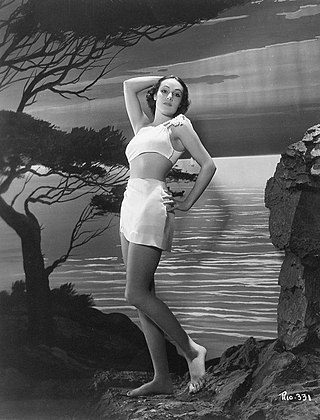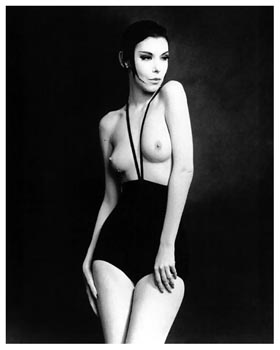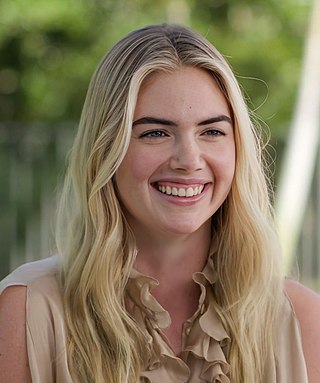Related Research Articles

A bikini is a two-piece swimsuit primarily worn by girls and women that features one piece on top that covers the breasts, and a second piece on the bottom: the front covering the pelvis but usually exposing the navel, and the back generally covering the intergluteal cleft and a little, some, or all of the buttocks. The size of the top and bottom can vary, from bikinis that offer full coverage of the breasts, pelvis, and buttocks, to more revealing designs with a thong or G-string bottom that covers only the mons pubis, but exposes the buttocks, and a top that covers only the areolae. Bikini bottoms covering about half the buttocks may be described as "Brazilian-cut", while those covering about three-quarters of the buttocks may be described as "cheeky" or "cheeky-cut". In May 1946, Parisian fashion designer Jacques Heim released a two-piece swimsuit design that he named the Atome ('Atom') and advertised as "the smallest swimsuit in the world". Like swimsuits of the era, it covered the wearer's belly button, and it failed to attract much attention. Clothing designer Louis Réard introduced his new, smaller design in July. He named the swimsuit after the Bikini Atoll, where the first public test of a nuclear bomb had taken place four days before. His skimpy design was risqué, exposing the wearer's navel and much of her buttocks. No runway model would wear it, so he hired a nude dancer from the Casino de Paris named Micheline Bernardini to model it at a review of swimsuit fashions.

A swimsuit is an item of clothing designed to be worn by people engaging in a water-based activity or water sports, such as swimming, diving and surfing, or sun-orientated activities, such as sun bathing. Different types may be worn by men, women, and children. A swimsuit can be described by various names, some of which are used only in particular locations, including swimwear, bathing suit, bathing attire, swimming costume, bathing costume, swimming suit, swimmers, swimming togs, bathers, cossie, or swimming trunks for men, besides others.

Christie Lee Brinkley is an American model, actress, and entrepreneur. Brinkley gained worldwide fame with her appearances in Sports Illustrated Swimsuit Issues, ultimately appearing on an unprecedented three consecutive covers in 1979, 1980, and 1981. She spent 25 years as the face of CoverGirl, has appeared on over 500 magazine covers, and has signed contracts with major brands; both fashion and non-fashion.

Heidi Klum is a German and American model, television host, producer, and businesswoman. She appeared on the cover of the Sports Illustrated Swimsuit Issue in 1998 and was the first German model to become a Victoria's Secret Angel.

The monokini was designed by Rudi Gernreich in 1964, consisting of only a brief, close-fitting bottom and two thin straps, was the first women's topless swimsuit. His revolutionary and controversial design included a bottom that "extended from the midriff to the upper thigh" and was "held up by shoestring laces that make a halter around the neck." Some credit Gernreich's design with initiating, or describe it as a symbol of, the sexual revolution.

Rudolf "Rudi" Gernreich was an Austrian-born American fashion designer whose avant-garde clothing designs are generally regarded as the most innovative and dynamic fashion of the 1960s. He purposefully used fashion design as a social statement to advance sexual freedom, producing clothes that followed the natural form of the female body, freeing them from the constraints of high fashion.

Cheryl Rae Tiegs is an American model and fashion designer. Frequently described as America's first supermodel, Tiegs made multiple appearances on the covers of the Sports Illustrated Swimsuit Issue and Time magazine. Her 1978 "Pink Bikini" poster became an iconic image of 1970s pop culture.

Toplessness refers to the state in which a woman's breasts, including her areolas and nipples, are exposed, especially in a public place or in a visual medium. The male equivalent is known as barechestedness.

Carol Ann Doda was an American topless dancer based in San Francisco, California, who was active from the 1960s through the 1980s. She was the first public topless dancer in the United States.
Marlborough School is an independent college-preparatory secondary school for girls in grades 7 through 12 at 250 South Rossmore Avenue in the Hancock Park neighborhood of Los Angeles, California. Marlborough was founded in 1889 by New England educator Mary Caswell and is the oldest independent girls' school in Southern California. In 2016, Town & Country magazine ranked Marlborough as the "best girls' school in America."

William James Claxton was an American photographer and author.

A handbra is the practice of covering female nipples and areolae with hands or arms. It often is done in compliance with censors' guidelines, public authorities and community standards when female breasts are required to be covered in film or other media. If the arms are used instead of the hands the expression is arm bra. The use of long hair for this purpose is called a hair bra.

The Condor Club nightclub is a striptease bar or topless bar in the North Beach section of San Francisco, California The club became famous in 1964 as the first fully topless nightclub in America, featuring the dancer Carol Doda wearing a monokini.

Many stylistic variations of the bikini have been created. A regular bikini is a two-piece swimsuit that together covers the wearer's crotch, buttocks, and breasts. Some bikini designs cover larger portions of the wearer's body while other designs provide minimal coverage. Topless variants are still sometimes considered bikinis, although they are technically not a two-piece swimsuit.

The thong is a garment generally used as either underwear or in some countries, as a swimsuit. It may also be worn for traditional ceremonies or competitions.

Alyssa Elaine Miller is an American model. She has done print and runway work for numerous leading companies. Among her highlights are cover appearances for Vogue (Germany) and Elle (Italy), work as a featured model–spokesperson for Guess, and appearances in the Sports Illustrated Swimsuit Issue.

Katherine Elizabeth Upton is an American model and actress. She first appeared in the Sports Illustrated Swimsuit Issue in 2011, and was the cover model for the 2012, 2013 and 2017 issues. In addition, she was the subject of the 100th-anniversary Vanity Fair cover.

Cameron Silver is fashion director, retailer, and entertainment personality. Silver is the currently fashion director of the brand Halston.
Patricia Faure was an American art dealer, photographer, and gallery owner, based in Los Angeles.
Exquisite Form is an American clothing brand for women's intimates, particularly bras and shapewear for full-figured women. The brand is owned by Vanity Fair Brands, a division of Fruit of the Loom.
References
- ↑ You're Never Too Young at IMDb
- 1 2 Drohojowska-Philp, Hunter (2011). Rebels in Paradise: The Los Angeles Art Scene and the 1960s. Macmillan. p. 96. ISBN 978-1-429-95899-8.
- ↑ Moore, Booth (March 3, 2013). "Cultural Touchstone: Peggy Moffitt". Los Angeles Times . Archived from the original on November 11, 2013.
- ↑ "Fashion, Freedom and the Total Look". LPK. 9 April 2015. Archived from the original on 4 September 2021. Retrieved 4 September 2021.
- ↑ "Fearless Fashion: Rudi Gernreich". Phoenix Art Museum. Retrieved 4 September 2021.
- ↑ Lowery, Allison (2013). Historical Wig Styling: Victorian to the Present. CRC Press. p. 194. ISBN 978-0-240-82124-5.
- 1 2 Hodge, Brooke (February 23, 2012). "Clothes Encounters: Rudi Gernreich, Peggy Moffitt and William Claxton". New York Times Magazine. Archived from the original on 20 September 2015. Retrieved 6 October 2015.
- ↑ "The Total Look: The Creative Collaboration between Rudi Gernreich, Peggy Moffitt, and William Claxton". Museum of Contemporary Art, Los Angeles . Retrieved 4 September 2021.
- ↑ ""The Total Look: Rudi Gernreich, Peggy Moffitt, and William Claxton," Cincinnati Art Museum, through May 24, 2015". March 24, 2015. Archived from the original on 4 March 2016. Retrieved 5 October 2015.
- ↑ "Peggy Moffit". Los Angeles Times. Archived from the original on 7 October 2015. Retrieved 6 October 2015.
- ↑ Smith, Liz (January 18, 1965). "The Nudity Cult". Sports Illustrated. Archived from the original on 5 November 2013. Retrieved 14 January 2013.
- ↑ Bay, Cody (June 16, 2010). "The Story Behind the Lines". Archived from the original on 4 July 2013. Retrieved 22 January 2013.
- ↑ "The Rudi Gernreich Book". Archived from the original on March 11, 2014. Retrieved 11 January 2013.
- ↑ "The First Monokini: Trying to make the Topless Swimsuit happen in 1964". Messy Nessy Chic. 5 March 2014. Retrieved 4 September 2021.
- ↑ Kalter, Suzy (May 25, 1981). "20 Remember Those Topless Suits? After a Cool-Out, Racy Rudi Gernreich Returns to the Fashion Swim". People Magazine. Archived from the original on 2011-01-10. Retrieved 14 January 2013.
The photographer on location in Montego Bay finally persuaded an adventurous local to wiggle into the designer's latest concoction: tight-fitting black knit bottoms held up with—gasp!—nothing more than a pair of skinny suspenders.
- ↑ "Peggy Moffitt in Rudi Gernreich, Topless Swimsuit (Getty Museum)". The J. Paul Getty in Los Angeles. Retrieved 4 September 2021.
- 1 2 Amorosi, A.D. "Q&A: Peggy Moffitt". The Philadelphia Citypaper. Archived from the original on 19 September 2012. Retrieved 11 January 2013.
- ↑ Miss Rosen (1 July 2019). "The Photograph That Rocked the Pop Culture Landscape". Feature Shoot. Retrieved 4 September 2021.
The idea for the monokini first came to Gernreich in December 1962 and first appeared in futuristic fashion feature in a late 1963 issue of Look magazine — after LIFE refused to publish them. In The Rudy Gernreich Book, Moffit recalls the editor at LIFE shamelessly told Claxton, "This is a family magazine, and naked breasts are allowed only if the woman is an aborigine."
- 1 2 "The Rudi Gernreich Book". Archived from the original on 10 August 2014. Retrieved 11 January 2013.
- ↑ Shteir, Rachel (1964). Striptease: The Untold History of the Girlie Show. East Pakistan Police Co-operative Society. pp. 318–321. ISBN 0-19-512750-1. Archived from the original on 2017-02-15.
- ↑ "The Rudi Gernreich Book". Archived from the original on 11 March 2014. Retrieved 11 January 2013.
- ↑ Jennifer Craik, The Face of Fashion, page 145, Routledge, 1993, ISBN 0203409426
- ↑ Walls, Jeanette (January 14, 1991). "High Fashion's Lowest Neckline". New York Magazine. New York Media, LLC. 24 (2): 21. ISSN 0028-7369.
- 1 2 Pinto, Phil (May 18, 2012). "Peggy Moffitt: The Total Look" (video). Retrieved 11 January 2013.[ permanent dead link ]
- ↑ "Peggy Moffitt". Vogue. No. 769. September 2014. p. 582. Archived from the original on September 28, 2015. Retrieved October 7, 2015.
- ↑ Martin, Douglas (October 14, 2008). "William Claxton, Photographer, Is Dead at 80". nytimes.com/. Archived from the original on January 6, 2018.